Microsoft BUILD: Windows 8, A Pre-Beta Preview
by Brian Klug & Ryan Smith on September 13, 2011 12:05 PM EST- Posted in
- BUILD
- Windows
- Microsoft
- Windows 8
- Trade Shows
The Metro UI
The best way to describe Windows 8 is a cross between the Metro UI from Window Phone 7 and the desktop architecture of Windows 7. In fact, virtually everything but the desktop gets a Metro treatment in Windows 8.
The Windows home screen starts initially hidden behind a lock screen virtually identical to WP7’s - slide up on a large edge-to-edge background to unlock. Inside is the Metro start screen, which is comprised of a grid of live application tiles that behave almost identically to those in Windows Phone 7. Two sizes of tiles serve as both application launch shortcuts and notification areas that can be populated with notifications, graphics, and other status indicators.
The tiles populate a horizontal strip that can be scrolled back and forth, and tiles can be rearranged accordingly. There are a few new gestures here over what we’ve seen before in WP7, including a swipe up to select a tile, and multitouch scrolling plus tile repositioning. Swipe up on tiles, and you can select them to convert size, uninstall, or unpin from the home screen.
The new start menu is more than a user experience oriented at tablets, it’s also the design language Microsoft has adopted for the entire new Windows 8 experience.
The thing to realize is that this modality isn’t so much a view as it is a combination of both new start menu, new interface for making Windows usable from a mobile perspective, and a completely new interaction paradigm. The interface is designed to perform and behave in the same way across multitouch, active digitizer, and keyboard+mouse combinations.
There’s another set of gestures and features as well which make use of the four edges of the display. The top and bottom are reserved for application-specific functions, the left and right are reserved for two Windows 8 specific tasks.
Sliding one’s finger from the left edge onto the display allows for both fast application changes, and the multiple-window snap functionality that’s been demoed already. The split is roughly 1:4 and divides horizontal real-estate between two applications views at once. The narrower of the two requires some additional development support, but the aim is to create a workable touch interface without sacrificing multitasking.
Swiping a finger from the right edge of the display towards the center brings up what Microsoft calls charms. This is a view that includes status indicators, and functionality like search, share, start, devices, and settings.
These respective shortcuts then bring up panes that occupy the same area on the right, and do what you’d expect. Settings for example is a place each application to build out a preferences area, so that each application has a common place users will go to control things.
Likewise, share acts like an intelligent copy paste, sharing working elements between applications. Finally search can either look through files and applications or dive into strings surfaced by other third-party applications.
These left and right based gestures exist across not just the Metro-infused start screen, but the entirety of Windows.
Moving around and getting back to the home screen is accomplished by pressing the Windows button, which on the tablet we were loaned is its own physical button analogous to iOS’ home button. Pressing the keyboard windows button performs the exact same action and summons the start menu.
The current set of first-party applications is pretty spartan. There’s no maps, mail, or camera application, though Microsoft has already bundled a set of its own internally-created applications. These are entirely Metro themed as well. I mention camera because the sample hardware includes a front facing and rear facing camera, and at present the only way to access them is through the change user tile picture function, which can capture a photo from the front or back webcam.
Throughout the entire OS is a very WP7-like virtual keyboard, which supports a full size and thumb keyboard mode. There’s also a handwriting recognition mode which has two lines of handwriting input and is styled similarly to Windows 7’s tablet input keyboard.
The keyboard can be docked to the bottom of the display or detached and dragged around as well. I find that the split keyboard accommodates typing with thumbs and holding the device midair quite well.


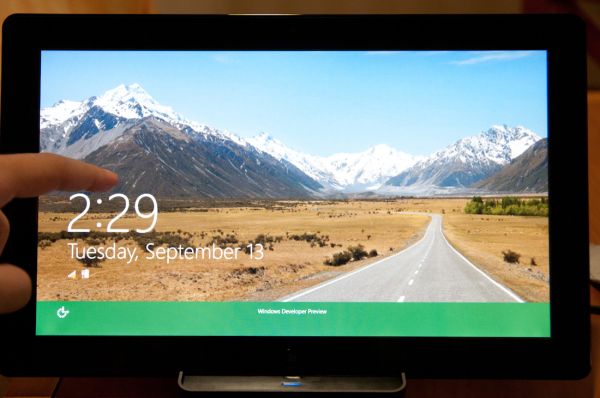
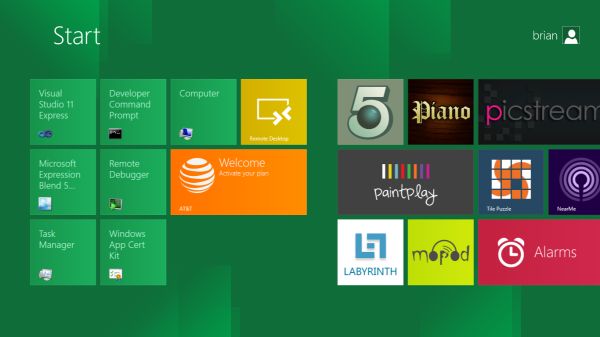
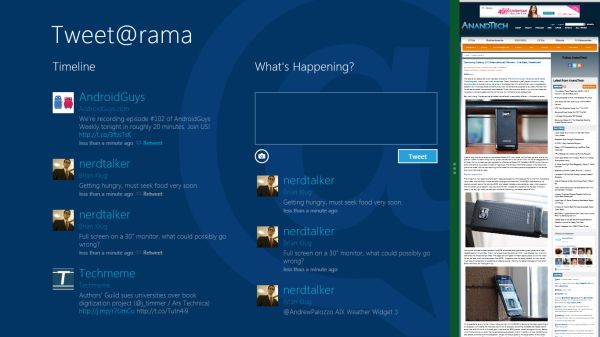
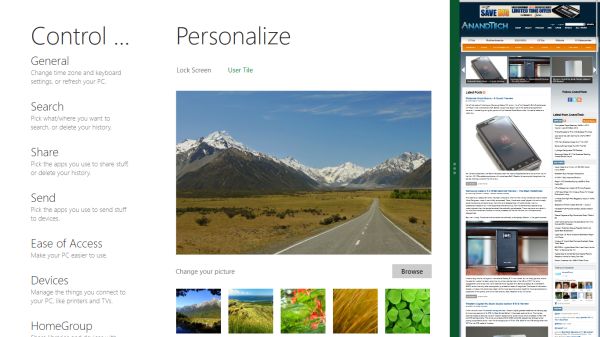

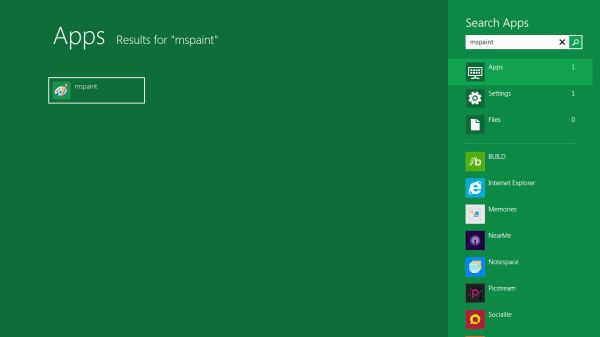
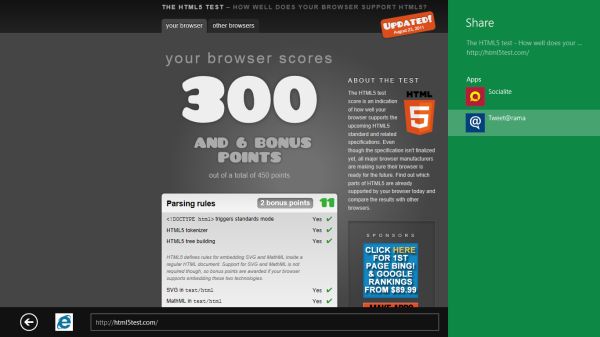
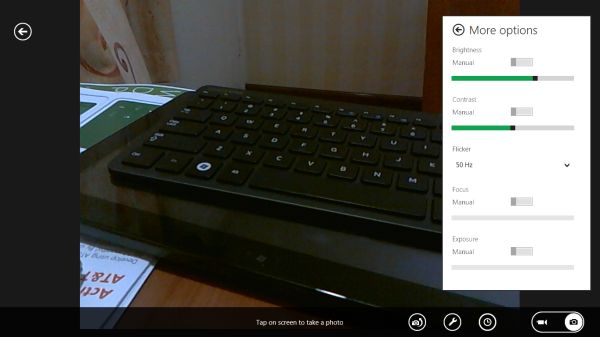
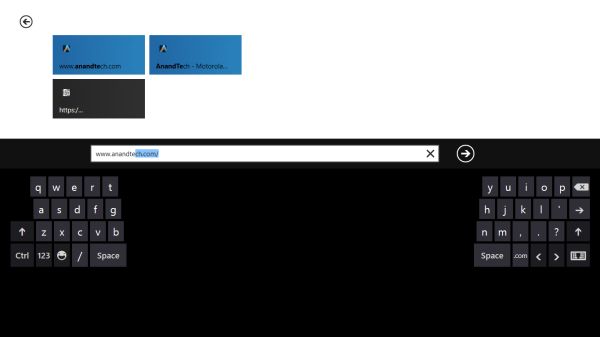








235 Comments
View All Comments
MGSsancho - Wednesday, September 14, 2011 - link
If we can not run explorer on out desktops then we will see the return of desktop shells ala lightstep, anston shell etcAdronson - Wednesday, September 14, 2011 - link
At about 6:20 in the video: "One big thing in Widows 8 is going to be the store."That about sums it up. Looks to me like all these active buttons will be there using system resources to get your attention. Little spam generators whose ultimate goal is to keep the user online so that it is easier to spend money.
PolarisOrbit - Wednesday, September 14, 2011 - link
Windows 8 looks like the best tablet OS by a tremendous margin.As a desktop OS, it looks terrible.
TEAMSWITCHER - Wednesday, September 14, 2011 - link
That's the problem. Tablet users will likely run ARM processors, and using an ARM processor the METRO GUI will be the only GUI on the system. And you can't run *ANY* existing windows apps, it must be a METRO app. I predict failure!BioTurboNick - Thursday, September 15, 2011 - link
Is that so different than current Tablet OSes? So you can get high-powered full Windows classic/Metro-capable tablets or a limited Metro-only ARM tablet.versesuvius - Wednesday, September 14, 2011 - link
On Windows 7, the single click option, just selected a file and executed it at the same time, in the windows explorer file manager. There was no clear space in the file manager windows to click in and set the focus to. It was the same with every other file manager I could find. It then just became useless to me. I reverted back to XP and am quite happy with it. It was the most ridiculous thing about Windows 7. I suppose usability now, three decade after the first PC or Mac is defined a bit differently. People now, know what computers and GUIs are. And most importantly they have a prior understanding of what a GUI should behave like. I hope that they have fixed that in Windows 8, although I am at no rate going to use it before the first service pack is released.piroroadkill - Thursday, September 15, 2011 - link
I use single click, have done for years, even on XP, but I never noticed this issue. I tend to use middle click to switch focus, especially when doing file operations.saganhill - Wednesday, September 14, 2011 - link
I love reading everyone’s comments how they hate the new GUI. Its reminiscence of the WinXP release and only now are users abandoning that OS for a new version.I have a premonition that all the people who "hate" the new GUI in windows 8 will in 5 years hate to give it up for the new one that MS will release. Very ironic.
UMADBRO - Wednesday, September 14, 2011 - link
All too true. Everytime something gets changed in a newer version of Windows, people piss and moan and act like they are going to pick up the pitchforks and torches and go raze Microsoft for their Blasphomy. Then after it comes out and people actually try it, theyre mostly like "Hey, thats not that bad after all! HERP!"I just wish all these complaining jackasses would go and give it a shot before whining and proclaiming their utter hate for it, without having ever tried it out. Wishful thinking, I guess.
Shinya - Wednesday, September 14, 2011 - link
most people have tried it ( like myself) and simply don't like it. i don't like have 20 FAT icons on my "desktop" that eat the entire landscape of my monitor. i want small icons. i want to be able to have 2 or more windows side by side while i multitask. As it stands right now (until other or myself figure it out) you cannot do such things with the Metro UI.working in the IT industry it is a must to have web and email side by side LIVE on the screen. not switching back n forth between the two.
but you're a troll (going just by you name), or a macf*g (in which case go back to engadget) so you wouldn't understand the words 'Computer" and 'Real Work'